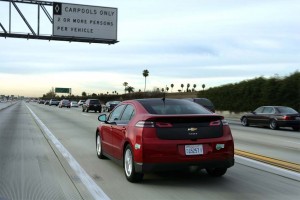It’s often the little things that matter – like the little sticker that buyers will now be able to attach to the bumper of the Chevrolet Volt that qualifies the plug-in hybrid to drive in the carpool lane on California highways even when there’s only one person in the vehicle.
Actually, that’s not such a small advantage for a motorist who can shave precious minutes off the daily commute. It’s one reason why the Toyota Prius long did so well in the traffic-choked Golden State – buyers sometimes paying as much as $5,000 more for a used hybrid with one of the limited stickers attached.
Unfortunately, the first Volts off the assembly line didn’t fall into the so-called P-ZEV – or “partial-zero-emissions vehicle” – category required to get the carpool sticker even though they could drive up to 30 miles or so entirely on battery power. Now, General Motors has corrected that problem and the updated Chevy Volt will not only get to drive solo in the carpool lane – saving an estimated 36 minutes a day in Southern California – but also earn a $1,500 state rebate.
“The Volts with the low emissions package are certain to be a strong draw for California commuters looking to travel the state’s notoriously congested freeways in the carpool lane,” proclaimed a clearly pleased Chris Perry, VP of Chevrolet marketing.
He’s certainly hoping so. Despite the headlines the plug-in hybrid drew when first introduced, several years ago, demand has been tepid, at best, since the Chevrolet Volt first came to market in the final weeks of 2010.
Last year, sales totaled barely 8,000, significantly short of the 10,000 the maker had been signaling. This year, the pressure is on to do better. GM officials have suggested they want to roll out 60,000 plug-in hybrids – which will include both the Volt and a European spin-off, the Opel Ampera. About three-quarters of those are earmarked for the U.S. market.
The Volt got off to a particularly poor start for 2011, perhaps no surprise considering the negative headlines generated by a pair of battery fires following federal crash tests. The National Highway Traffic Safety Administration has since given the plug-in a clean bill of health, and GM has come up with a fix to ensure the car is even safer – while noting there have been no fires in real world driving.
Nonetheless, the Chevy Volt has become a pawn in Washington politics, a Republican-led committee holding hearings into the supposed safety issue that ultimately served to bash the Obama Administration and again decry the 2009 GM bailout.
Since then, GOP presidential hopeful Newt Gingrich has continued the bashing, this week mocking the battery car because “You can’t put a gun rack in a Volt,” apparently like a he-man pickup.
In a blog entry, GM PR chief Selim Bingol fired back,” Actually, you can. But the real question is, “Why would you?” In both examples: It looks weird; It doesn’t work very well, and There are better places for gun racks and training wheels — pickup trucks and little Schwinns, respectively. Seriously, when is the last time you saw a gun rack in ANY sedan?”
Actually, it turns out you can put a gun rack in a Volt, as a new video on YouTube demonstrates.
But in California, at least, more buyers are likely to want that carpool sticker. And vehicles meeting the P-ZEV mandate should be at most of GM dealerships in the state by the end of the month, according to company officials.
It remains to be seen how Chevy dealers will handle them. Will they charge more for a qualifying Chevrolet Volt – or even discount the plug-ins that don’t qualify? One thing is clear: Volt sales clearly need to be charged up.

